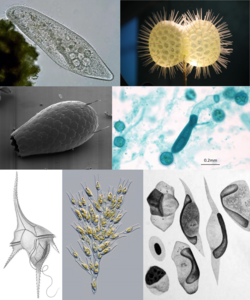Biology:SAR supergroup
| SAR | |
|---|---|

| |
| Scientific classification | |
| Domain: | Eukaryota |
| Clade: | Diaphoretickes |
| Clade: | TSAR |
| Clade: | SAR Burki et al., 2007 |
| Infrakingdoms | |
| |
| Synonyms | |
| |
SAR or Harosa is a highly diverse clade of eukaryotes, often considered a supergroup,[2] that includes stramenopiles (heterokonts), alveolates, and rhizarians.[3][4][5] It is a node-based taxon, including all descendants of the three groups' last common ancestor,[6] and comprises most of the now-rejected Chromalveolata.[2] Their sister group has been found to be telonemids, with which they make up the TSAR clade.[7]
Etymology
The name SAR is an acronym derived from the first letters of its three constituent clades;[lower-alpha 1] it has been alternatively spelled "RAS".[6][8] The term "Harosa" (at the subkingdom level) has also been used, with Stramenopiles replaced by its synonym Heterokonta in this variant of the acronym.[9]
History of discovery
Before the discovery of the SAR supergroup, stramenopiles and alveolates were classified in the supergroup Chromalveolata alongside haptophytes and cryptomonads, being believed to have acquired plastids through secondary endosymbiosis of red algae through a common ancestor.[2] Meanwhile, Rhizaria was traditionally considered to be a separate supergroup. More recent phylogenetic studies confirmed that stramenopiles and alveolates diverged with rhizarians as part of the SAR lineage.[10] This clade has been found by later phylogenomic studies to be robustly characterized compared to other supergroups.[7]
This groups excludes haptophytes and cryptomonads, hypothesized to have acquired plastids in separate endosymbiosis events,[11] leading Okamoto et al. (2009) to propose the clade Hacrobia to accommodate them.[12]
Diversity
The SAR supergroup encompasses a variety of morphologies and ecological niches, from microscopic zoo- and phytoplankton to massive kelp forests. The group includes both photosynthetic and non-photosynthetic forms. Photosynthesis arose independently across various stramenopiles and alveolates lineages through secondary or higher-order endosymbiosis events, acquiring plastids of red algal origin,[13][11] while chlorarachniophyte rhizarians captured plastids from green algae, retaining vestigial nucleomorphs.[14]
It has been estimated that SAR encompasses up to half of all eukaryotic diversity.[2]
Owing to the clade's discovery through phylogenomics, there are no known synapomorphies uniting its various members.[3] This was already the case for its subclade Rhizaria, established earlier through similar means. On the other hand, Stramenopiles is well-defined morphologically, characterized by an anterior flagellum with tripartite bristles (mastigonemes), while Alveolata is united by the presence of cortical alveoli.[15]
Nonetheless, studies of telonemids, believed to be the sister group to SAR, have revealed characteristics such as tripartite hair and peripheral vacuoles, potentially homologous to similar structures in stramenopiles and alveolates. This brings into light the possibility of these structures being ancestrally shared by the clade, with cortical alveoli originating from peripheral vacuoles under this hypothesis.[7]
Internal phylogeny
A 2021 analysis places Alveolata and Stramenopiles in Halvaria, as sister to Rhizaria.[11]
| TSAR |
| ||||||||||||||||||
See also
- Amoebozoa
- Archaeplastida
- Excavata
- Opisthokonta
Notes
- ↑ As a formal taxon, "Sar" has only its first letter capitalized, while the earlier abbreviation, SAR, retains all uppercase letters. Both names denote the same group of organisms, unless further taxonomic revisions deem otherwise.
References
- ↑ , Wikidata Q24614721
- ↑ 2.0 2.1 2.2 2.3 Burki, Fabien; Roger, Andrew J.; Brown, Matthew W.; Simpson, Alastair G.B. (January 2020). "The New Tree of Eukaryotes". CellPress 35 (1): 43–55. doi:10.1016/j.tree.2019.08.008.
- ↑ 3.0 3.1 "Phylogenomics reshuffles the eukaryotic supergroups". PLOS ONE 2 (8): e790. August 2007. doi:10.1371/journal.pone.0000790. PMID 17726520. Bibcode: 2007PLoSO...2..790B.
- ↑ "Phylogenomic analyses support the monophyly of Excavata and resolve relationships among eukaryotic "supergroups"". Proceedings of the National Academy of Sciences of the United States of America 106 (10): 3859–64. March 2009. doi:10.1073/pnas.0807880106. PMID 19237557. Bibcode: 2009PNAS..106.3859H.
- ↑ "Ancient recruitment by chromists of green algal genes encoding enzymes for carotenoid biosynthesis". Molecular Biology and Evolution 25 (12): 2653–67. December 2008. doi:10.1093/molbev/msn206. PMID 18799712.
- ↑ 6.0 6.1 "The revised classification of eukaryotes". The Journal of Eukaryotic Microbiology 59 (5): 429–93. September 2012. doi:10.1111/j.1550-7408.2012.00644.x. PMID 23020233.
- ↑ 7.0 7.1 7.2 "New Phylogenomic Analysis of the Enigmatic Phylum Telonemia Further Resolves the Eukaryote Tree of Life". Molecular Biology and Evolution 36 (4): 757–765. April 2019. doi:10.1093/molbev/msz012. PMID 30668767.
- ↑ "An overview of the phylogeny and diversity of eukaryotes". Journal of Systematics and Evolution 46 (3): 263–273. 2008. doi:10.3724/SP.J.1002.2008.08060. https://pdfs.semanticscholar.org/c325/1ef9a0d7b00bc5e011df5dbf37629f42c4f5.pdf.
- ↑ "Kingdoms Protozoa and Chromista and the eozoan root of the eukaryotic tree". Biology Letters 6 (3): 342–5. June 2010. doi:10.1098/rsbl.2009.0948. PMID 20031978.
- ↑ Ancestor's Tale. Houghton Mifflin Harcourt. 2016. pp. 573–577. ISBN 978-0-544-85993-7.
- ↑ 11.0 11.1 11.2 Strassert JF; Irisarri I; Williams TA; Burki F (March 2021). "A molecular timescale for eukaryote evolution with implications for the origin of red algal-derived plastids". Nature Communications 12 (1): 1879. doi:10.1038/s41467-021-22044-z. PMID 33767194. Bibcode: 2021NatCo..12.1879S.
- ↑ "The eukaryotic tree of life from a global phylogenomic perspective". Cold Spring Harbor Perspectives in Biology 6 (5): a016147. May 2014. doi:10.1101/cshperspect.a016147. PMID 24789819.
- ↑ McFadden, G. I. (2001). "Primary and secondary endosymbiosis and the origin of plastids". Journal of Phycology 37 (6): 951–959. doi:10.1046/j.1529-8817.2001.01126.x.
- ↑ "The puzzle of plastid evolution". Current Biology 19 (2): R81-8. January 2009. doi:10.1016/j.cub.2008.11.067. PMID 19174147.
- ↑ Grattepanche, Jean David (March 2018). "Microbial Diversity in the Eukaryotic SAR Clade: Illuminating the Darkness Between Morphology and Molecular DataDarkness Between Morphology and Molecular Data". BioEssays. doi:10.1002/bies.201700198.
Wikidata ☰ Q137323 entry
 |


